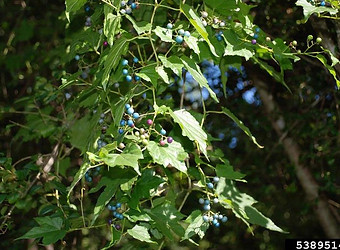
INVASIVE VINES

Image from Leslie J. Mehrhoff, University of Connecticut, Bugwood.org
Black Swallow-wort
(Vincetoxicum nigrum/Cynanchum louiseae)
Black swallow-wort is a perennial, herbaceous vine without tendrils. The seed pods look similar to milkweed pods. Black swallow-wort invades forests and open areas, and is not common in the state. For more information, see WDNR and Minnesota Wildflowers. CWIP also created a quick ID guide for this species.


Image from Peter M. Dziuk, MinnesotaWildflowers.info
Golden Creeper/Manchu Tubergourd/Red Hailstone
(Thladiantha dubia)
Golden creeper is a perennial, herbaceous vine with tendrils, yellow flowers, and hairy heart-shaped leaves. It invades a variety of habitats, but only a few infestations have been identified in the state. For more information, visit SEWISC and Minnesota Wildflowers. CWIP also created a quick ID guide for this species.

Image from Katy Chayka, MinnesotaWildflowers.info
Japanese Hops
(Humulus japonicus)
Japanese hops is an annual, herbaceous vine that invades streambanks. The leaves usually have 5-7 lobes. Native common hops has fewer lobes. Japanese hops is not common in the state. For more information, see the WDNR and Minnesota Wildflowers.
Oriental Bittersweet
(Celastrus orbiculatus)
Oriental bittersweet is woody vine that grows in forests and open areas. American bittersweet is similar, but native. To differentiate between these two species, see this USGS Factsheet. Oriental bittersweet is somewhat common in the state. For more information about oriental bittersweet, visit WDNR and see this quick ID guide that CWIP created.

Image from Nancy Loewenstein, Auburn University, Bugwood.org
Porcelain Berry
(Ampelopsis brevipedunculata/ Ampelopsis glandulosa var. brevipedunculata)
Porcelain berry is a woody perennial vine that invades forests and open areas. Porcelain berry has multi-colored berries and leaves that look similar to wild grape. It is not common in the state. For more information, see WDNR and Virginia Native Plant Society. CWIP also created a quick ID guide for this species.
More species to be added soon!

